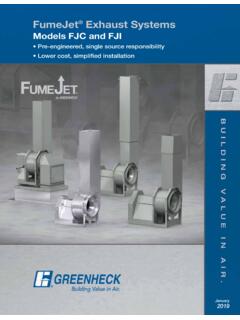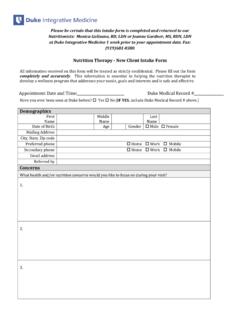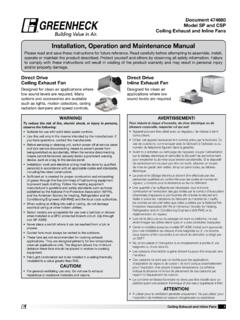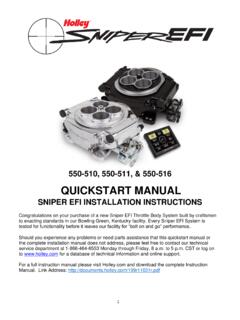Transcription of ExhaustGas Scrubber WashwaterEffluent
1 United States Environmental Protection Agency Office of Wastewater Management Washington, DC 20460 exhaust Gas Scrubber washwater effluent EPA 800 R 11 006 November 2011 exhaust Gas Scrubber washwater effluent Contents CONTENTS Page SECTION 1 INTRODUCTION .. 1 SECTION 2 exhaust GAS Scrubber TECHNOLOGY .. 4 Seawater 5 Freshwater 7 Hybrid and Dry Scrubbers .. 8 SECTION 3 exhaust GAS Scrubber washwater 9 SECTION 4 IMO GUIDELINES FOR EGCSS, washwater MONITORING AND DISCHARGE CRITERIA .. 10 washwater Monitoring .. 10 Continuous Discharge Limits .. 10 10 PAHs .. 11 Turbidity/Suspended Particulate Matter (Solids).
2 11 Other Discharge Limits .. 12 12 washwater Additives and Other Substances .. 12 washwater 12 Periodic 12 SECTION 5 CHARACTERIZATION OF POLLUTANTS IN EGCS washwater DISCHARGES .. 13 The MS Zaandam Seawater Scrubber Trials .. 13 The Pride of Kent Seawater Scrubber 18 The Suula Freshwater Scrubber Trial .. 23 Summary of Marine EGCS Scrubber Trials .. 25 SECTION 6 ASSESSMENT OF POLLUTANTS DISCHARGED IN Scrubber washwater AND PROTECTIVENESS OF IMO GUIDELINES .. 26 28 30 Turbidity .. 32 Nitrate .. 33 Sulfate, COD and Dissolved Oxygen .. 34 35 Summary .. 36 SECTION 7 38 SECTION 8 40 i exhaust Gas Scrubber washwater effluent Contents LIST OF TABLES Page 1 PAH Discharge Concentration Limit by Flow Rate.
3 11 2 Concentrations of Metals in the washwater Discharge from the Zaandam Scrubber Trial ..17 3 Concentrations of PAHs in the Seawater Intake and washwater Discharge from the Pride of Kent Scrubber 4 Approximate Amount of Water (t/hr) Affected by a Scrubber for a 12 MW Engine ..30 LIST OF FIGURES Page 1 SOx Scrubber Components ..4 2 The EcoSilencer Scrubber Installed on the Pride of Kent ..5 3 Open Type Wet 4 Closed Type Wet Scrubber ..7 The EPA contacts for this document are Ryan Albert (202) 564-0763 and Shirley Fan (202) 564 2425. ii exhaust Gas Scrubber washwater effluent Executive Summary EXECUTIVE SUMMARY This document contains information about effluent washwater discharges associated with the operation of exhaust gas cleaning systems (EGCSs), also known as sulfur oxide (SOx) scrubbers, onboard vessels.
4 The use of scrubbers to clean the exhaust from marine engines using high sulfur residual oil and diesel fuels is an option for reducing SOx air emissions required by Annex VI of the MARPOL International Convention for the Prevention of Pollution from Ships. washwater generated by an EGCS can contain contaminants from three sources: 1. Pollutants scavenged from the exhaust gas exiting the engine (combustion products, fuel and lubricants); 2. The source of washwater used to clean the exhaust (seawater or freshwater); and 3. The Scrubber itself (dissolution of materials, possible reaction products and/or chemical additives). The deployment of SOx scrubbers to treat emissions from diesel engines on large ocean going vessels has been so far limited to a handful of ships.
5 However, the use of SOx scrubbers in combination with high sulfur residual oil fuels may be an economically attractive option in Sulfur Oxide Emission Control Areas (SECAs) and worldwide. As the deadlines for SOx reduction1 draw nearer, some vessels may begin using scrubbers to reduce SOx emissions rather than burning low sulfur fuel oil. This document describes the basic technology of EGCS, treatment processes used to remove pollutants from washwater prior to discharge, guidelines established by the International Maritime Organization (IMO) for washwater monitoring and discharge criteria, available onboard sampling data characterizing the constituent concentrations in washwater discharge, and impacts of Scrubber washwater discharge on water quality and aquatic life and protectiveness of IMO guidelines.
6 1 The revised Annex VI entered into force on July 1, 2010. The sulfur content of fuel will fall in the Emission Control Areas (ECAs), which include the Baltic Sea, the North Sea and the English Channel, from to 1% in July 2010 and to in January 2015. A North American ECA, which includes waters adjacent to the Pacific, Atlantic and Gulf coasts and the 8 main Hawaiian Islands, will become enforceable in 2012. Globally, the highest permitted sulfur content of fuel will fall from to in January 2012 and to in January 2020. iii exhaust Gas Scrubber washwater effluent Section 1 - Introduction SECTION 1 INTRODUCTION The International Convention for the Prevention of Pollution from Ships (MARPOL), 1973 as modified by the Protocol of 1978, also known as MARPOL 73/78, Annex VI Prevention of Air Pollution from Ships, requires the reduction of SOx emissions either by burning low sulfur fuel oil or cleaning the exhaust gas.
7 Cleaning, or scrubbing, the exhaust gas is generally accepted to be more economical. According to EGCS manufacturer W rtsil , the cost saved by using heavy fuel oil instead of low sulfur fuel oil can pay back the cost of installing and operating EGCS in about one year (Hatley, 2010). The EGCSs used today for sulfur control are commonly known as SOx scrubbers. In a wet Scrubber , the exhaust gas is mixed with washwater , and the water-soluble components of the exhaust gas are removed by dissolution into the washwater . SOx scrubbers are capable of removing up to 95 percent of SOx from ship exhaust (EGCSA, 2010). By removing sulfur from the exhaust , the Scrubber also removes most of the direct sulfate particulate matter (PM).
8 Sulfates are a large portion of the PM from ships operating on high sulfur fuels. By reducing the SOx emissions, the Scrubber also controls much of the secondary PM that is formed in the atmosphere from these emissions. There are two main types of wet Scrubber technologies. The first wet Scrubber technology, referred to as seawater scrubbing, is an open-loop design which uses seawater to scrub the exhaust before discharging the washwater back to the sea following treatment. In a seawater Scrubber , the exhaust gases are brought into contact with seawater, either through spraying seawater into the exhaust stream or routing the exhaust gases through a water bath. The sulfur dioxide (SO2) in the exhaust gas dissolves in the washwater , where it is ionized to bisulphate and sulfite, which are then readily oxidized to sulfate (Hassell v and Turner, 2007).
9 The ionization of SO2 and the sulfuric acid formed from sulfur trioxide (SO3) also produces acidity. The sulfuric acid in the water then reacts with carbonates and other salts in the seawater to form sulfates (USEPA, 2009a). The washwater is treated to remove solids and raise the pH prior to discharge back to sea. The removed solids are stored onboard for shoreside disposal. The second wet Scrubber technology is a closed-loop system. Freshwater is used as washwater , and caustic soda is injected into the washwater to neutralize the sulfur in the exhaust . A small portion of the washwater is bled off and treated to remove suspended solids. The suspended solids are held as sludge and disposed of shoreside as with the open loop design.
10 The treated bleed-off washwater can be discharged at open sea or held onboard for disposal shoreside. Additional freshwater is added to the system as needed. While this design is not a completely closed loop, it can be operated in zero discharge mode for a period of time (USEPA, 2009a). 1 exhaust Gas Scrubber washwater effluent Section 1 - Introduction Wet scrubbers are a well-established technology for SOx and PM reduction that are widely used in stationary sources such as land based oil and coal fired power plants. In these applications, lime and caustic soda are typically used to neutralize the sulfuric acid in the washwater . The first use of exhaust gas scrubbers in the marine industry was not for SOx emission control but rather as an inexpensive means to produce inert gas for reducing the fire hazard in the cargo tanks of tankers while unloading.















